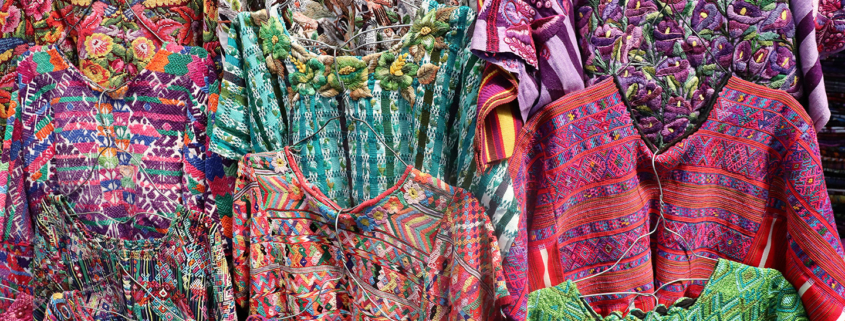The Story of Traje: Guatemala’s Traditional Clothing
In Guatemala, colorful clothing is a core part of the artistry of the culture. Trajes (or trajés) are no exception. Indigenous women wear these vibrant traditional outfits to represent their community. Each color and visual design motif in the garments has some association with the community it was made in.
In this quick guide, discover exactly what a traje is, the clothing’s complex history, and why trajes are so meaningful in Guatemalan culture.
What Is A Trajé?
Trajes are traditional clothing, ensembles designed and worn by Mayan women in Mexico, Guatemala, and Belize. Each outfit incorporates five pieces of clothing.
The first piece is a loom-woven, two-piece blouse or tunic-like dress called a huipil, which comes from the Náhuatl term for covering. The second piece is the bottom of the outfit: an indigo-dyed wrap skirt called a corte. The seams of the corte are traditionally embroidered with an intricate floral or geometric pattern called randa.
Trajes then add the third piece, the faja. A faja is a striped fabric belt, tied at the waist of the outfit. Many traditional Mayan cultures use black and white for the faja to represent the night sky, or our place in the universe.
The fourth piece of the ensemble is the rebozo, a long shawl that can be wrapped in a loop to carry a baby. Rebozo colors often represent both the community and motherhood.
The traje ensemble is complete with a corte, a hair adornment of headband with wide variation among communities. Some cortes are akin to ribbons or scarves, while others are more structured headdresses.
The Complex History of el Traje de Guatemala
While the weaving techniques and visual elements likely date back to early eras of Mayan civilization, trajés design and aesthetics were formally established in the 1520s. Modern trajés evolved from this initial order.
In that decade, Spanish conquistadors forced indigenous people to wear specific colors and patterns that indicated where they lived and what community they were a part of. These colored identification patterns were used to segregate and target the different Indigenous groups and discriminate against them, as well as levy punitive taxes against the groups.
However, over the centuries, the Mayan cultural communities infused the colors and patterns with new meaning. The people in these Indigenous Guatemalan communities used the colors to create pride in their community and resilience against oppression. The patterns and colors became much like hometown flags: symbols of a place you love, and a way to memorialize people you’ve lost.
Mayan Women’s Cultural Heritage: Traje Is Guatemalan Women’s Clothing
Trajés are among the most iconic versions of Mayan traditional clothing from Guatemala. Today, they are solely created and worn by women.
Traditional Guatemalan clothing for men and women differed, and men do not practice the traditional backloom weaving the outfits are made with. Instead, women keep the practice alive.
That said, while Guatemalan men tend to wear modern clothes, many do wear the fabric faja belts to show community pride.
Experience Guatemala’s History And Culture With Caravan
Traveling should be stress-free. At Caravan, it is!
Our guides curate all-inclusive trips to beautiful destinations with expertise. Traditional cultural events, transportation, and meals are hand-picked and booked well ahead of time. The only thing left to do is enjoy!
If you’re interested in experiencing the rich culture and history of Guatemala, why not check out our 8-Day Tour of Guatemala, Antigua, and Atitlán?
If you’d like to join in, or just want more information, we invite you to call us toll-free at 1-800-CARAVAN or 1-800-312-321-9800.
